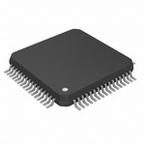●The ultra-low-power STM32L151xC and STM32L152xC devices incorporate the connectivity power of the universal serial bus (USB) with the high-performance ARM® Cortex®-M3 32-bit RISC core operating at a frequency of 32 MHz (33.3 DMIPS), a memory protection unit (MPU), high-speed embedded memories (Flash memory up to 256 Kbytes and RAM up to 32 Kbytes) and an extensive range of enhanced I/Os and peripherals connected to two APB buses.
●The STM32L151xC and STM32L152xC devices offer two operational amplifiers, one 12-bit ADC, two DACs, two ultra-low-power comparators, one general-purpose 32-bit timer, six general-purpose 16-bit timers and two basic timers, which can be used as time bases.
●Moreover, the STM32L151xC and STM32L152xC devices contain standard and advanced communication interfaces: up to two I2Cs, three SPIs, two I2S, three USARTs and an USB. The STM32L151xC and STM32L152xC devices offer up to 23 capacitive sensing channels to simply add a touch sensing functionality to any application.
●They also include a real-time clock and a set of backup registers that remain powered in Standby mode.
●Finally, the integrated LCD controller (except STM32L151xC devices) has a built-in LCD voltage generator that allows to drive up to 8 multiplexed LCDs with the contrast independent of the supply voltage.
●The ultra-low-power STM32L151xC and STM32L152xC devices operate from a 1.8 to 3.6 V power supply (down to 1.65 V at power down) with BOR and from a 1.65 to 3.6 V power supply without BOR option. They are available in the -40 to +85 °C and -40 to +105 °C temperature ranges. A comprehensive set of power-saving modes allows the design of low-power applications.
●Key Features
● Ultra-low-power platform
● 1.65 V to 3.6 V power supply
● -40 °C to 105 °C temperature range
● 0.29µA Standby mode (3 wakeup pins)
● 1.15 µA Standby mode + RTC
● 0.44 µA Stop mode (16 wakeup lines)
● 1.4 µA Stop mode + RTC
● 8.6 µA Low-power run mode
● 185 µA/MHz Run mode
● 10 nA ultra-low I/O leakage
● 8 µs wakeup time
● Core: ARM® Cortex® -M3 32-bit CPU
● From 32 kHz up to 32 MHz max
● 1.25 DMIPS/MHz (Dhrystone 2.1)
● Memory protection unit
● Reset and supply management
● Low-power, ultrasafe BOR (brownout reset) with 5 selectable thresholds
● Ultra-low-power POR/PDR
● Programmable voltage detector (PVD)
● Clock sources
● 1 to 24 MHz crystal oscillator
● 32 kHz oscillator for RTC with calibration
● High Speed Internal 16 MHz factory-trimmed RC (+/- 1%)
● Internal Low-power 37 kHz RC
● Internal multispeed low-power 65 kHz to 4.2 MHz PLL for CPU clock and USB (48 MHz)
● Pre-programmed bootloader
● USB and USART supported
● Development support
● Serial wire debug supported
● JTAG and trace supported
● Up to 83 fast I/Os (70 I/Os 5V tolerant), all mappable on 16 external interrupt vectors
● Memories
● 256 Kbytes of Flash memory with ECC
● 32 Kbytes of RAM
● 8 Kbytes of true EEPROM with ECC
● 128-byte backup register
● LCD Driver (except STM32L151xC devices) up to 8x40 segments, contrast adjustment, blinking mode, step-up converter
● Rich analog peripherals (down to 1.8 V)
● 2x operational amplifiers
● 12-bit ADC 1Msps up to 25 channels
● 12-bit DAC 2 channels with output buffers
● 2x ultra-low-power-comparators(window mode and wake up capability)
● DMA controller 12x channels
● 9x peripheral communication interfaces
● 1x USB 2.0 (internal 48 MHz PLL)
● 3x USARTs
● Up to 8x SPIs (2x I2S, 3x 16 Mbit/s)
● 2x I2Cs (SMBus/PMBus)
● 11x timers: 1x 32-bit, 6x 16-bit with up to 4 IC/OC/PWM channels, 2x 16-bit basic timers, 2x watchdog timers (independent and window)
● Up to 23 capacitive sensing channels
● CRC calculation unit, 96-bit unique ID



